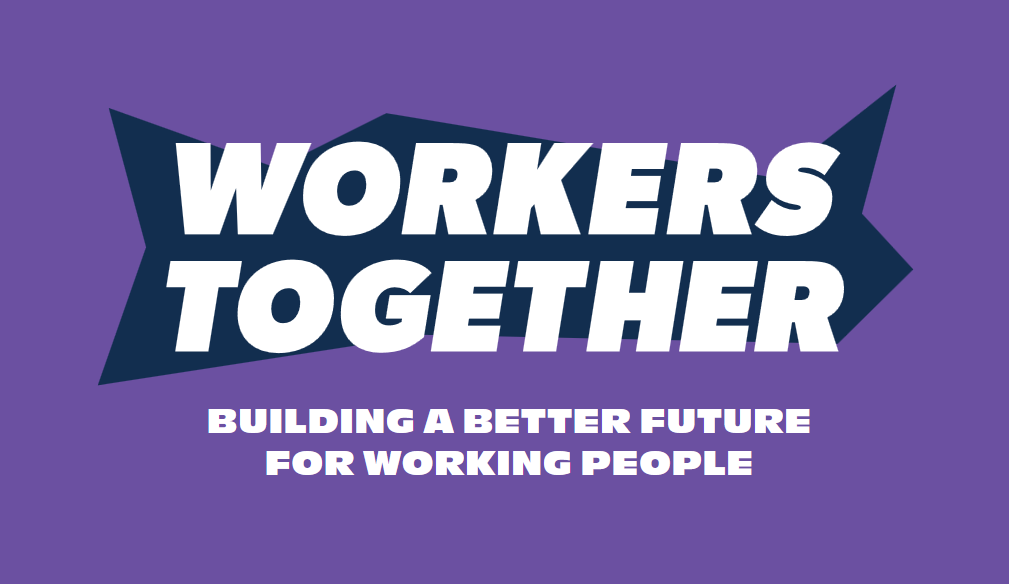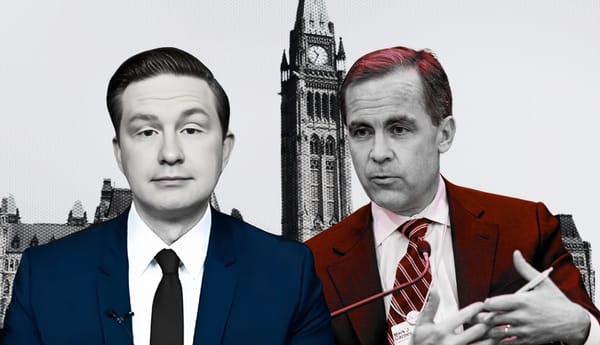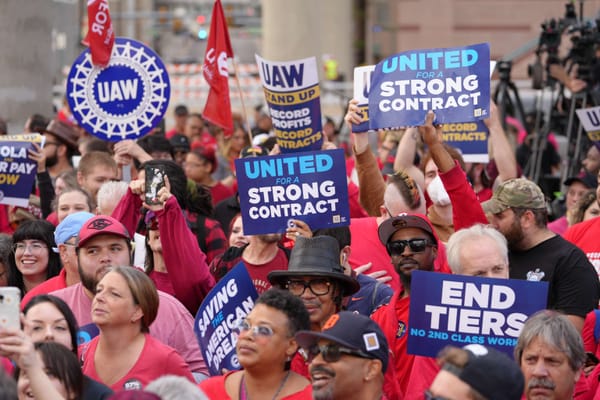
A new report from the Parkland Institute in Alberta highlights the nefarious ways in which governments interfere in public sector collective bargaining. It is essential reading for workers, unions and anyone concerned with the protection of fundamental labour rights in Canada.
A Thumb on the Scale: Alberta Government Interference in Public-Sector Bargaining examines the legislative and non-legislative means through which collective bargaining rights are being systematically undermined, both in Alberta and across Canada more broadly.
The report’s authors, Jason Foster, Bob Barnetson and Susan Cake, make a compelling case that government interference is subverting workers’ and union rights, that such interference is becoming increasingly opaque, sophisticated, and effective, and that coordination and mobilization in the labour movement is necessary to fight back.
The report documents the various ways governments in Canada have historically intervened in public sector collective bargaining and limited workers’ rights. Notably, the authors find that this type of interference has increased markedly since 2000, despite favourable legal decisions that were supposed to limit the government coercion of labour. As the authors demonstrate, the rate of government interventions in collective bargaining has nearly tripled over the past two decades.
Additionally, A Thumb on the Scale documents the “strategic adaptations” governments have made in order to continue interfering in collective bargaining while nevertheless appearing to respect the letter of the law.
For example, the authors highlight the broad use of “mandates” to impose strict bargaining limits on public sector employers and therefore restrict the scope of negotiations. Rather than legislate specific contract provisions, governments instead mandate wage caps or place other constraints on public sector employers. In this way, the appearance of free collective bargaining is maintained, even as unions have the scope of their negotiations curtailed through government-imposed mandates.
Perhaps most troubling is the growing use of non-legislative interventions highlighted by Foster, Barnetson and Cake. These include various formal and informal actions taken by governments to influence the outcomes of union negotiations, without the use of legislation. As the report documents, several provincial governments have placed informal pressure on public sector employers, become directly involved in bargaining without acknowledging their role, and even threatened unions.
As its title suggests, the report has a particular focus on Alberta, the province where these trends are most pronounced and where the government is most ideologically committed to rolling back workers’ rights. In 2019, the Alberta government passed the Public Sector Employers Act, authorizing the minister of finance to issue secret and binding bargaining mandates to most public sector employers. These “secret mandates” are not public and unions have no knowledge of their contents during negotiations. Secret mandates are a novel and disturbing innovation in Canadian industrial relations and could be transposed or emulated in other Canadian jurisdictions if labour isn’t on guard.
As the report concludes, government interference in collective bargaining is becoming much more effective due to these various legislative and non-legislative tools. If Alberta’s recent experience is any indication, labour across the country could soon face growing challenges from emboldened governments bent on imposing austerity in the form of public sector union contract concessions.
A Thumb on the Scale is a sobering yet necessary read. It documents an alarming, if longstanding, political trend of governments running roughshod over workers’ rights. Indeed, according to the International Trade Union Confederation’s 2023 “Global Rights Index,” which annually tracks countries’ performance when it comes to the protection of union and worker rights, Canada is a country that regularly violates workers’ rights.
Such rights violations are anything but recent. For several decades, governments across Canada have intervened in public sector collective bargaining, most aggressively in the form of back-to-work legislation to force union members to end lawful strikes.
In 1985, Leo Panitch and Donald Swartz published From Consent to Coercion: The Assault on Trade Union Freedoms, a highly influential book tracking what those authors described as the “permanent exceptionalism” of government interference in collective bargaining. Panitch and Swartz’s book, since updated and reprinted in four editions, argued that trade union rights in Canada had become increasingly circumscribed, particularly by governments’ use of back-to-work legislation.
In the years since the book first appeared, two seemingly contradictory trends emerged. On the one hand, governments appeared to become ever-more brazen in their legislative interferences in public sector collective bargaining — ostensibly confirming what Panitch and Swartz, as well as many others, had argued. On the other hand, a series of labour cases made their way to the Supreme Court of Canada (SCC) and recognized union rights to bargain and strike as protected by the Charter of Rights and Freedoms.
These SCC decisions, most notably Saskatchewan Federation of Labour v. Saskatchewan in 2015, were supposed to reduce governments’ ability to interfere with public sector collective bargaining and workers’ right to strike. In practice, the impact of these labour-friendly decisions has been mixed, at best.
Instead of governments being constrained by the courts, legislative limitations on workers’ rights have in many ways grown more impudent. Not content, and less able, to simply drop the hammer of back-to-work legislation after strikes have begun (though this still happens not infrequently), provincial governments have resorted to limiting the scope of negotiations, legislating wage restraint and thus undermining free collective bargaining, and at times imposing contract provisions.
In other words, as the legal bar protecting union rights was raised, governments became increasingly daring and clever when circumventing public sector collective bargaining.
As Foster explained to Class Struggle, “Governments are highly motivated to maintain the strategic advantage that they have by using these kinds of interference [in collective bargaining]. But they want to figure out how to keep interfering while doing the absolute minimum to abide by the Charter of Rights and Freedoms.”
The penalties for transgressing workers’ rights and defying the law, however, are often paltry at best. “I think governments have figured out that they won’t pay any short-term political price most of the time for these kinds of interventions. Maybe a court case will come down the road, years later, but that’ll be a future government’s problem,” Foster added. “Governments recognize that the short-term political gain outweighs any potential legal problems they might get themselves into down the road.”
This was very likely the calculation of Doug Ford’s government in Ontario when it imposed Bill 124 capping public sector wages at 1 per cent annually for three years (since struck down as unconstitutional) and when it attempted to legislate a contract on education workers.
Courts are also ill-equipped to deal with the various oversteps of provincial and federal governments, according to Foster. For instance, though an Ontario court found Bill 124’s wage restraint unconstitutional, in Manitoba, a similar bill mandating public sector wages was previously upheld on appeal. The legal tests for determining ‘lawful’ rather than excessive government interference, from the outside, appear arbitrary and capricious.
Moreover, the use of bargaining mandates and other less visible forms of interference obscures the full extent of violations of workers’ rights, as A Thumb on the Scale documents.
“Many governments have figured out that mandates and other less blatant forms of interference are actually more effective than legislation. They can find a way to put their thumb on the scale, as the report’s title suggests, to significantly influence the outcome of negotiations without even having to do the heavy lifting of legislating,” Foster told Class Struggle.
In Alberta, these trends are especially pronounced. “Alberta has taken non-legislative interference a step further, much further. In other provinces, unions have known about the mandates. In Alberta, the mandates are secret so no one even knows about their contents. I suspect that governments around the country may start looking at this as a model.”
This year, roughly 200,000 union members will be negotiating new collective agreements in Alberta, including nearly 80 per cent of the public sector. Foster, Barnetson and Cake’s research thus arrives at a pressing moment. The multiple ways that governments — particularly the United Conservative Party government in Alberta — undermine workers’ right to free collective bargaining should encourage unions to take seriously the forces and factors they are up against.
As Foster told Class Struggle, however, having such a large number of workers all entering bargaining in the same year in Alberta is also an important strategic opportunity.
“Unions need to figure out how to coordinate among themselves better. Governments are clearly trying to coordinate public sector employers and impose these strict bargaining mandates on them. Unions could do more to coordinate their common demands and to line up their collective agreements. What the Common Front did in Quebec should serve as a model for public sector unions in other provinces.”
Most importantly, Foster concluded, “Unions need to be prepared to mobilize their members for collective action to defend their rights.”
Foster added: “The labour movement needs to recognize that there are significant limitations to using the legal system to try to defend workers’ rights. Even when unions get favourable decisions at the Supreme Court, those victories prove pyrrhic in the end. They don’t cement workers’ rights in the ways that we hoped. Challenges in the courts can’t be the only tool in the toolbox.”
A Thumb on the Scale offers several recommendations for how labour should respond to growing government interference in collective bargaining, from demanding greater transparency from government to better coordinating demands across unions.
However, the most important weapon in the fight remains union members themselves. Only a mobilized and organized union membership can strike sufficient fear in governments who trample on workers’ rights at every opportunity.
Recent Class Struggle Issues
- February 26 | An Interview With The New President Of CAPE
- February 19 | The Growing Popularity Of Right-To-Work Laws Is Troubling
- February 12 | It’s Time For Anti-Scab Legislation In Every Jurisdiction
- February 5 | Saskatchewan Teachers Fighting For Working And Learning Conditions







